Method For Image Reconstruction Using Low-Dimensional-Structure Self-Learning and Thresholding
- Summary
- Abstract
- Description
- Claims
- Application Information
AI Technical Summary
Benefits of technology
Problems solved by technology
Method used
Image
Examples
Embodiment Construction
[0018]An improved method for reconstructing images from undersampled image data, such as k-space data acquired with a magnetic resonance imaging (“MRI”) system; x-ray projection data acquired with an x-ray imaging system, such as a computed tomography (“CT”) system; or the like, is provided. The method is generally referred to as “low-dimensional-structure self-learning and thresholding” (“LOST”), and utilizes structure from an underlying image to improve the reconstruction process. Generally, a low resolution image from a substantially fully-sampled portion of the image data, such as the central portion of k-space, is reconstructed, from which image blocks containing similar image characteristics, such as anatomical characteristics, are identified. These image blocks are arranged into “similarity clusters,” which are subsequently processed for de-aliasing and artifact removal using underlying low-dimensional properties. Alternatively, other methods can be implemented to reconstruct...
PUM
 Login to View More
Login to View More Abstract
Description
Claims
Application Information
 Login to View More
Login to View More - R&D
- Intellectual Property
- Life Sciences
- Materials
- Tech Scout
- Unparalleled Data Quality
- Higher Quality Content
- 60% Fewer Hallucinations
Browse by: Latest US Patents, China's latest patents, Technical Efficacy Thesaurus, Application Domain, Technology Topic, Popular Technical Reports.
© 2025 PatSnap. All rights reserved.Legal|Privacy policy|Modern Slavery Act Transparency Statement|Sitemap|About US| Contact US: help@patsnap.com



